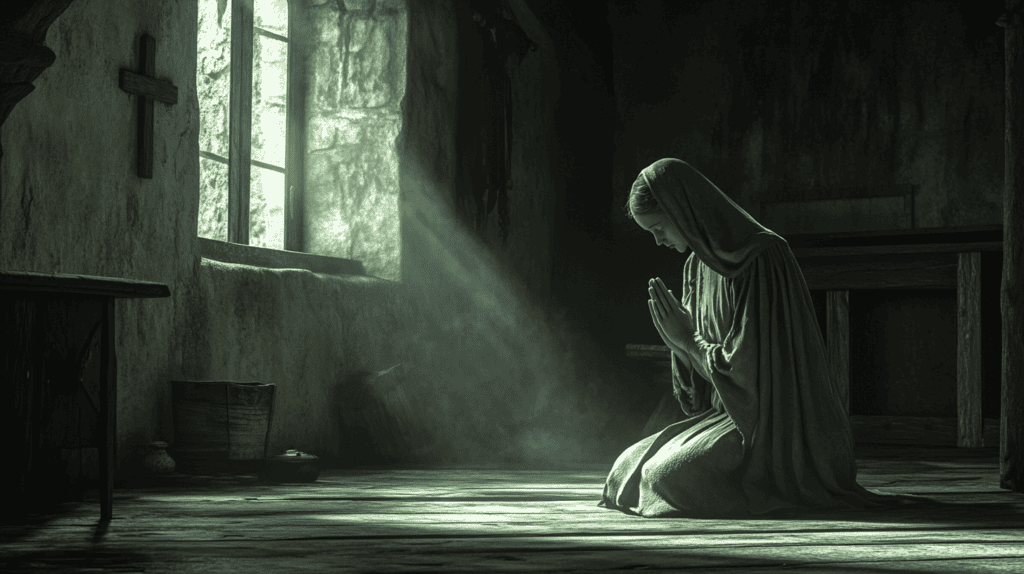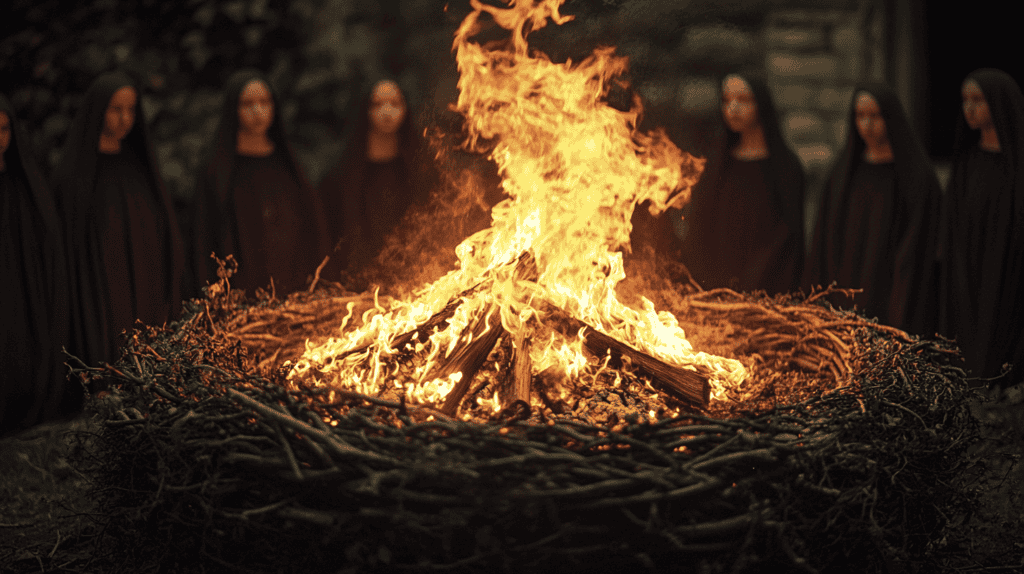
St. Brigid of Kildare, born in AD 450, stands as one of the most revered figures in Irish history and Christianity. Her life, marked by extraordinary acts of charity, miraculous events, and unwavering devotion, has left an indelible mark on Irish culture and spirituality.
From Humble Beginnings to Spiritual Greatness
Born in Faughart, near Dundalk in County Louth, Brigid’s early life was a blend of pagan and Christian influences. Her father, Dubhthach, was a pagan chieftain of Leinster, while her mother, Broicsech, was a Christian. This unique upbringing would shape Brigid’s worldview and set the stage for her future as a bridge between Ireland’s pagan past and its Christian future.
From a young age, Brigid exhibited an extraordinary compassion for the poor and a deep connection to the natural world. Legends tell of her taking food and butter from her mother’s pantry to give to those in need, foreshadowing the boundless generosity that would become her hallmark.
The Call to Religious Life
As Brigid approached adulthood, her father sought to arrange a marriage for her, as was customary for women of her social standing. However, Brigid had other plans. Determined to dedicate her life to God and service, she made a bold and unconventional choice.
According to tradition, Brigid prayed fervently that her beauty be taken away, hoping to deter potential suitors. Her prayer was answered in a most unexpected way – she temporarily lost her beauty, freeing her to pursue her spiritual calling. This act of divine intervention not only allowed Brigid to follow her chosen path but also demonstrated her unwavering faith and commitment to her beliefs.

At the age of 15, Brigid received the veil from St. Macaille, marking her official entry into religious life. This pivotal moment set her on a path that would lead to the founding of numerous convents and the establishment of one of Ireland’s most influential monasteries.
The Miracle of the Expanding Cloak
Perhaps the most famous legend associated with St. Brigid is the miracle of her expanding cloak. This story not only showcases Brigid’s faith and ingenuity but also her determination to serve God and her community.
The tale begins with Brigid approaching the King of Leinster, seeking land to build a convent. She explained that the location she desired was perfect – it had a forest nearby for firewood, a lake for water, and fertile land for crops. The king, amused by her request, refused.
Undeterred, Brigid prayed for divine intervention and then made a clever proposition to the king. She asked if he would grant her as much land as her cloak could cover. The king, seeing how small her cloak was, agreed, thinking it a harmless jest.
What happened next astonished all who witnessed it. Brigid spread her cloak on the ground and asked four of her companions to hold each corner. As they walked in different directions – north, south, east, and west – the cloak miraculously expanded, covering acres of land.

The king, witnessing this incredible event, realized that Brigid was truly blessed by God. Humbled and awestruck, he not only granted her the land but also provided money, food, and supplies for her convent. Moreover, the king himself converted to Christianity, inspired by Brigid’s faith and the miracle he had witnessed.
This legend of the expanding cloak has become a powerful symbol of Brigid’s ability to create space for all, embodying the Irish saying, “There’s room for everyone under Brigid’s cloak”. It represents her inclusive spirit and her capacity to bring people together under the banner of faith and compassion.
The Monastery of Kildare: A Beacon of Learning and Faith
With the land granted by the king, Brigid founded her most famous monastery in Kildare around the year 470. This establishment would become one of the most prestigious monasteries in Ireland and a center of learning renowned throughout Christian Europe.
What set Brigid’s monastery apart was its unique structure – it was a double monastery, housing both nuns and monks. This innovative approach reflected Brigid’s belief in equality and her desire to create a community where men and women could serve God side by side.

As the abbess of this thriving spiritual community, Brigid wielded considerable power. Yet, historical accounts describe her as a wise and prudent leader, guiding her flock with compassion and foresight. Under her leadership, the monastery at Kildare became famous for its artwork, particularly its beautifully illuminated manuscripts and intricate metalwork.
The monastery also included an art school where work was done with metal and illumination. The famous Illuminated Manuscripts of Kildare, created in the scriptorium of this facility, are praised for their beauty and are considered among the oldest illuminated manuscripts in Church history.
Brigid’s Miracles and Acts of Compassion
Throughout her life, Brigid was associated with numerous miracles, many of which reflected her deep compassion for the poor, the sick, and animals. These acts of divine intervention, whether factual or legendary, paint a picture of a woman whose faith was intrinsically linked to acts of kindness and generosity.
One of the most well-known miracles attributed to Brigid involves her ability to multiply food and drink for those in need. It is said that when she churned butter, she would give a large portion to the poor, only to find that the butter was miraculously replenished. Similarly, she is credited with somehow producing enough beer from a single barrel to satiate the parishioners of 18 different churches, earning her a place among the patron saints of beer.

Brigid’s miracles often involved healing and protecting animals, reflecting her connection to nature and her role as a protector of the vulnerable. These acts of compassion extended to all creatures, great and small, cementing her reputation as a friend to both humans and animals alike.
The Brigidine Fire: A Symbol of Enduring Faith
One of the most enduring symbols associated with St. Brigid is the perpetual fire that burned in her honor at the Kildare monastery. This flame, tended by 19 nuns, was said to have burned continuously from Brigid’s time until the Reformation in the 16th century.
The fire held deep symbolic meaning, representing the light of Christ and the enduring faith of Brigid and her followers. It was surrounded by a circular hedge, creating a sacred space that was strictly off-limits to men. The 12th-century chronicler Giraldus Cambrensis warned that any man rash enough to enter this area would face divine retribution.

Though the original fire was extinguished during the Reformation, its symbolism and significance have not been forgotten. In 1993, the Brigidine Sisters reignited a new perpetual flame at the Solas Bhríde Centre and Hermitages near Kildare town. This modern incarnation of Brigid’s fire continues to burn as a beacon of hope, justice, and peace for the world.
Brigid: A Bridge Between Pagan and Christian Traditions
One of the most intriguing aspects of St. Brigid’s story is how she seems to embody both pagan and Christian traditions. This duality reflects the complex religious landscape of Ireland during the transition from paganism to Christianity.
Before the arrival of Christianity, Brigid was known as a powerful Celtic goddess. She was revered across Europe, from Turkey to Spain, as a triple goddess associated with healing, fire, and poetry. In Irish mythology, she was one of the Tuatha dé Danann, daughter of the Dagda and the Morrigan.
As Christianity spread across Ireland, many aspects of the goddess Brigid were incorporated into the veneration of St. Brigid. This syncretism allowed for a smoother transition between the old and new faiths, with St. Brigid becoming a bridge between Ireland’s pagan past and its Christian future.
The blending of pagan and Christian traditions is evident in many aspects of St. Brigid’s story and symbolism. For instance, the St. Brigid’s Cross, now a common Christian symbol in Ireland, has roots in pre-Christian traditions. Similarly, the perpetual fire at Kildare, while given Christian significance, echoes earlier pagan practices of maintaining sacred flames.
This interweaving of traditions has made St. Brigid a figure of fascination and reverence for people from various spiritual backgrounds.

Brigid’s Enduring Legacy
St. Brigid’s influence extends far beyond her lifetime, reaching across the centuries to inspire and guide people today. Her feast day, February 1st, has recently been declared a national holiday in Ireland, making it the first Irish public holiday named after a woman. This recognition speaks to the enduring power of Brigid’s story and her continued relevance in modern Irish culture.
Her establishment of the monastery at Kildare, her numerous miracles, and her role in bridging Ireland’s pagan and Christian traditions have left an indelible mark on Irish history and spirituality.




